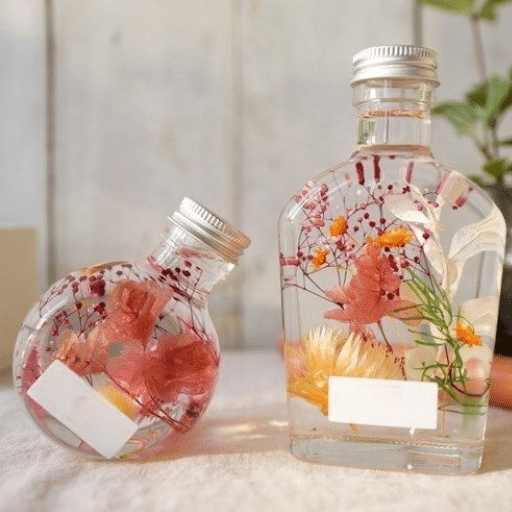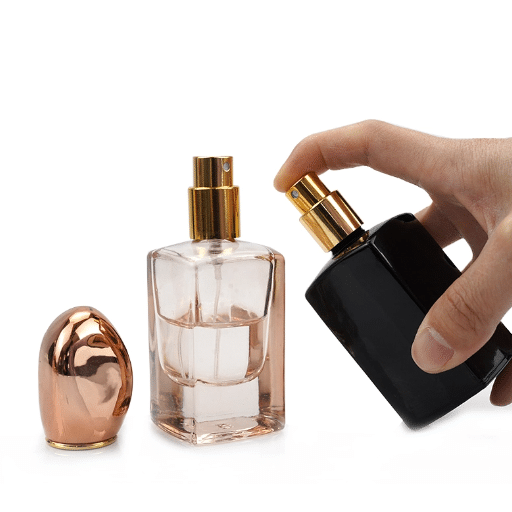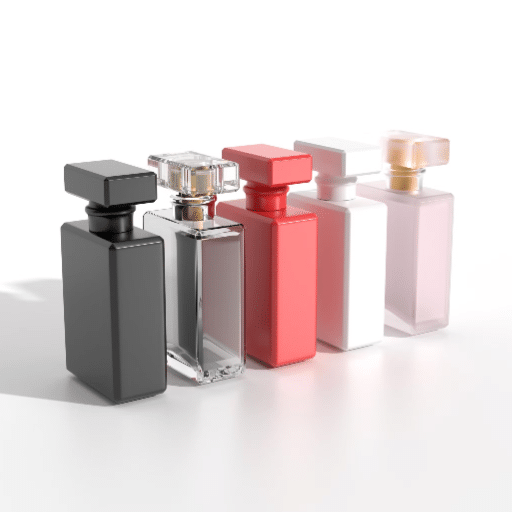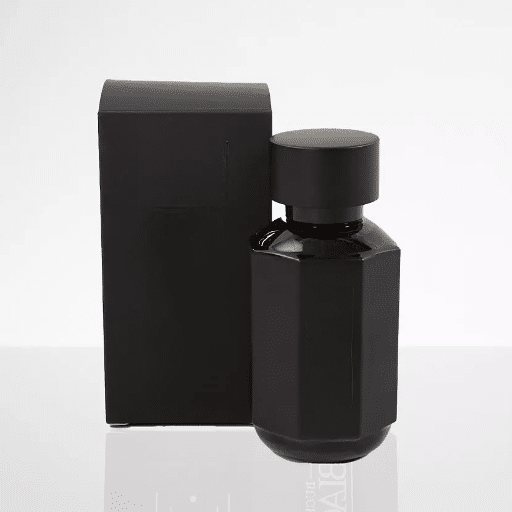Antique perfume bottles are not just vessels for storing scented liquids but are fine specimens of art, history, and craftsmanship. These timeless treasures speak of bygone eras, human ingenuity, and the evolving tastes and cultural values of their time.
Collector’s Note: Each bottle—from elaborately designed glass creations to rare hand-carved renditions—represents a unique marriage of beauty, culture, and utility. Whether you’re an experienced collector, vintage aesthetics enthusiast, or someone with curiosity about antique treasures, this exploration will deepen your appreciation for these delicate artifacts.
The Fascinating History of Antique Perfume Bottles
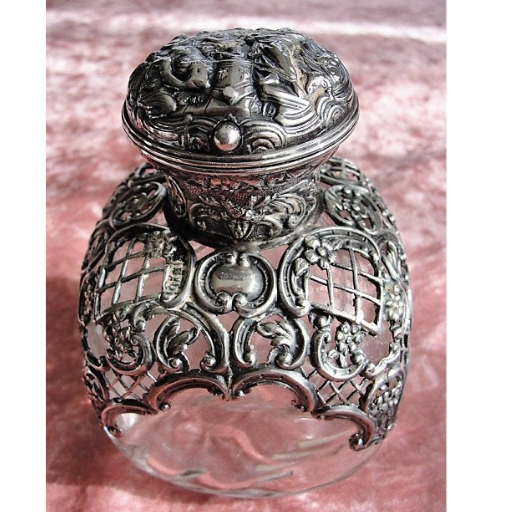
The story of perfume bottles begins in ancient civilizations, where the Egyptians and Mesopotamians laid the foundation for both perfumery and the art of bottle making. These early containers, crafted from clay, alabaster, and glass, showcased the remarkable skills of ancient artisans.
Origins and Ancient Beginnings
Tracing perfume bottles back to ancient history reveals their origins in Egypt and Mesopotamia, where perfumes held sacred significance and symbolized high status. The earliest containers were fashioned from:
Alabaster
Prized for its translucent beauty and ability to preserve precious oils
Clay
Practical and widely available, often decorated with intricate patterns
Stone
Durable and prestigious, carved by skilled craftsmen
The advent of glassblowing techniques around the 1st century BCE in the Roman Empire marked a revolutionary shift toward more refined and sophisticated bottle designs, representing a significant advancement in container artistry.
Evolution Through the Renaissance and Beyond
During the Renaissance and into the 18th century, perfume bottle designs began reflecting the artistic and cultural zeitgeist of their respective eras. The 19th and early 20th centuries witnessed the creation of the most coveted glass designs, with renowned houses like Lalique and Baccarat leading the artistic revolution.
| Era | Key Characteristics | Notable Features | Famous Makers |
|---|---|---|---|
| Ancient Period | Clay, stone, alabaster vessels | Sacred and ceremonial use | Egyptian and Mesopotamian artisans |
| Roman Empire | Introduction of glassblowing | More refined shapes and clarity | Roman glassmakers |
| Renaissance | Artistic cultural expression | Decorative elements, cultural motifs | European craftsmen |
| 19th-20th Century | Fine crystal, elaborate designs | Art objects, precision craftsmanship | Lalique, Baccarat |
Types of Antique Perfume Bottles
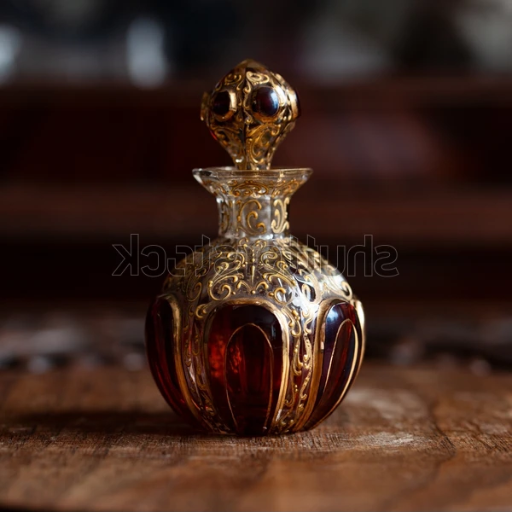
Antique perfume bottles come in various styles, each reflecting the artistic movements and cultural preferences of their time. Understanding these different types helps collectors identify and appreciate their unique characteristics.
Victorian Glass Bottles
Heavily decorated and delicately crafted, these bottles feature hand-painted decorations, wire etching, or floral motifs. Popular in the late 19th century, they’re now highly coveted for their elegance and intricate workmanship.
Art Deco Perfume Bottles
Characterized by geometric shapes, bold colors, and revolutionary designs from the 1920s-1930s. Materials included crystal, glass, and Bakelite, expressing the sleek, modernistic aesthetic of the era.
Cut Crystal Bottles
Renowned for their breathtaking beauty and finely detailed facets that skillfully scatter light. These artisan-made bottles are considered premium collectibles.
Porcelain Perfume Bottles
Made from fine porcelain with hand-painted and gilded decorations. Popular in 18th and 19th century Europe and Asia, featuring luxurious designs.
Novelty Bottles
Distinguished by unusual shapes and whimsical themes, popular from the late 19th to mid-20th century. Often featured animals, figures, or miniature objects.
Miniature Perfume Bottles
Tiny bottles holding small amounts of perfume, popular as travel-friendly options. Frequently decorated with delicate details, these are among the most sought-after collectibles.
Materials and Craftsmanship
The materials used in vintage perfume bottles were chosen for their elegance, durability, and ability to preserve fragrances. Each material offered unique aesthetic and functional properties.
Primary Materials Used
| Material | Characteristics | Advantages | Notable Examples |
|---|---|---|---|
| Fine Glass | Transparent, moldable, decorative potential | Visibility of contents, artistic possibilities | Lalique, Baccarat creations |
| Crystal | High clarity, brilliant light reflection | Premium appearance, collectible value | Cut crystal masterpieces |
| Porcelain/Ceramic | Hand-painted decorations, fine colors | Artistic expression, unique designs | European and Asian pieces |
| Metals (Silver/Gold) | Ornamental caps and design elements | Added prestige, durability | Victorian overlay bottles |
| Rubber/Cork | Tight-fitting stoppers | Practical seal maintenance | Functional closure systems |
Glass vs. Other Materials
Glass Advantages: Glass stands out for its unique combination of transparency, durability, and versatility. Unlike porcelain or metals, glass allows visibility of contents, making it ideal for storage and display. From an environmental perspective, glass is increasingly favored as a recyclable, eco-friendly option over plastics.
Alternative Materials: While porcelain offers elegance with hand-painted decorations, it lacks transparency. Metals like copper or brass provide durability but may corrode without proper treatment. Each material serves specific aesthetic and functional purposes.
Unique Features of Antique Bottles
Atomizers and Pump Systems
Many antique perfume bottles featured sophisticated dispensing systems that were both functional and beautiful. These mechanisms represent early innovations in perfume application technology.
- Fine Mist Dispersion: Created perfectly even applications while conserving product
- Reusable Design: Built for refilling, making them environmentally conscious and cost-effective
- Controlled Dosage: Precision pumps prevented excessive use or spillage
- Travel-Friendly: Compact, lightweight designs perfect for portability
- Customizable Styles: Available in various decorative patterns and finishes
Decorative Elements and Finishes
Antique perfume bottles showcased various decorative techniques that enhanced both beauty and functionality:
- Frosted surfaces for elegant texture and privacy
- Etched patterns creating intricate visual designs
- Hand-painted decorations with precious metal accents
- Colored glass tints for aesthetic appeal
- Embossed manufacturer marks and ornamental details
Notable Brands and Iconic Designers
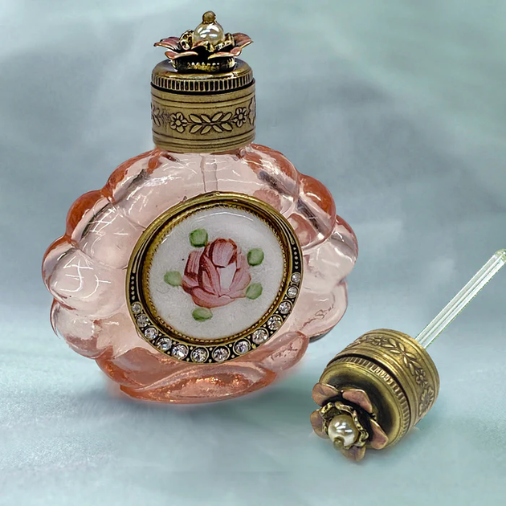
Legendary Perfume Bottle Designers
| Designer | Style | Notable Contributions | Famous Works |
|---|---|---|---|
| René Lalique | Art Nouveau | Revolutionized glass artistry in perfume bottles | Iconic frosted glass designs |
| Pierre Dinand | Modern Innovation | Contemporary luxury bottle designs | Yves Saint Laurent’s Opium |
| Marc Rosen | Artistic Luxury | FiFi award-winning designs | Luxury brand collaborations |
Distinctive Features of Renowned Brands
Leading perfume houses have successfully combined timeless artistry with modern consumer needs, creating bottles that serve as both functional containers and collectible art pieces:
- Chanel & Dior: Iconic designs appealing across generations
- Diptyque & Le Labo: Champions of minimalism and sustainability
- Lalique & Baccarat: Masters of crystal and fine glass artistry
- Limited Editions: Exclusive designs combining rarity with artistic value
Collecting and Authentication Guide
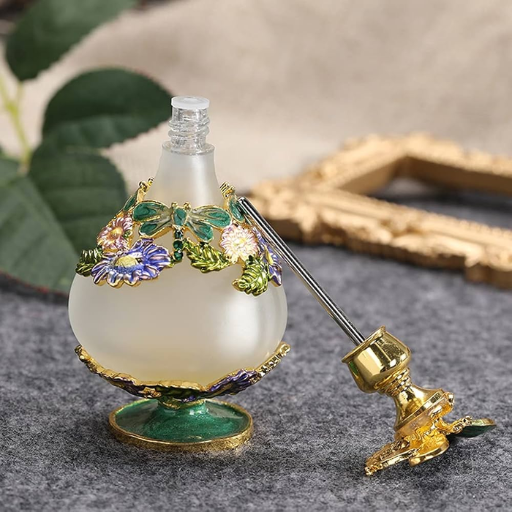
Identifying authentic antique perfume bottles requires knowledge, attention to detail, and understanding of historical craftsmanship techniques.
Key Characteristics of Genuine Pieces
Authentication Checklist: Genuine antique bottles exhibit specific features that distinguish them from reproductions or forgeries. Understanding these characteristics is essential for collectors.
| Feature | Authentic Indicators | What to Look For |
|---|---|---|
| Seam Lines | Stop before the lip | Hand-made before automatic machines (pre-1900s) |
| Pontil Marks | Present on base | Created by traditional glassmaking finishing process |
| Glass Quality | Air bubbles, amber hues | Irregularities indicating handmade craftsmanship |
| Maker’s Marks | Embossed or etched clearly | Manufacturer name, date, country of origin |
| Stopper Fit | Precise, perfect fit | Hand-ground to exact specifications |
Common Forgery Signs to Avoid
- Inconsistent Craftsmanship: Uneven painting, mismatched patterns, distorted proportions
- Inaccurate Markings: Casual or amateur-looking embossing of maker’s marks
- Material Discrepancies: Wrong weight, texture, or material composition
- Modern Manufacturing Signs: Machine-made characteristics in supposedly hand-crafted pieces
Verification Resources
Multiple tools and resources can help authenticate antique perfume bottles:
- Online databases for cross-referencing serial numbers and maker’s marks
- Expert appraisal services and collector forums
- Auction house records and historical catalogues
- Google Lens for image comparison with verified pieces
- Physical examination of weight, texture, and workmanship details
Care and Preservation
Proper care ensures that antique perfume bottles maintain their beauty and value for future generations.
Essential Care Guidelines
- Environment: Keep away from direct sunlight and extreme temperatures
- Cleaning: Regular dusting with soft cloths maintains clarity and luster
- Storage: Store upright to prevent spilling or damage to seals
- Handling: Use clean hands and gentle movements when examining
- Documentation: Maintain records of provenance and condition
Where to Find Antique Perfume Bottles
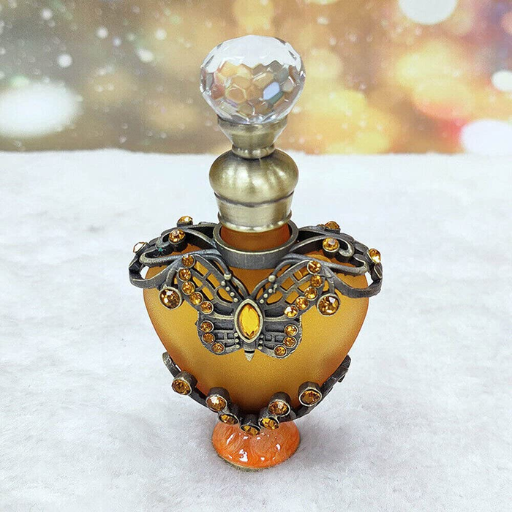
Collectors can discover authentic pieces through various channels, each offering different advantages and price ranges.
| Source | Advantages | Considerations | Best For |
|---|---|---|---|
| Antique Shops | Physical examination, expert guidance | Limited selection, higher prices | Quality pieces, authentication help |
| Flea Markets | Lower prices, unique finds | Authentication challenges | Bargain hunting, common pieces |
| Estate Sales | Original context, fair prices | Limited time, competition | Complete collections, rare finds |
| Online Auctions | Wide selection, competitive pricing | No physical examination | Specific searches, research tools |
| Collector Groups | Expert knowledge, networking | Membership requirements | Learning, rare acquisitions |
References
-
Comparing Effectiveness of Intensive Hybrid and Traditional Formats – A study examining the effectiveness of hybrid formats compared to traditional methods.
-
A Correlational Study on Components of Hybrid Course Delivery – Research exploring the outcomes and components of hybrid delivery formats.
Frequently Asked Questions (FAQ)
What are antique perfume bottles, really, and why are they so important?
Historically, antique bottles would have been decorative perfume containers for keeping fragrances since the 19th and early 20th centuries. Antique perfume bottles are valued for their beauty and historical or cultural importance. In other words, they are prized by collectors for the craftsmanship and artistry behind them.
How do I tell if my antique perfume bottle is genuine?
When deciding if an antique perfume bottle is genuine or not, it’s essential to study the design, the materials in question, and any markings from the manufacturer. Signs of age may be found on glass or ornate lids, but also investigate whether provenance can be provided. In these cases, manufacturers such as René Lalique & François Coty garner a high degree of collectability.
What materials are usually used for creating antique perfume bottles?
They made antique perfume bottles with all kinds of materials: glass, crystal, porcelain, and even for the fanciest, some kind of metal, usually sterling silver. Some of them are superbly decorated with exquisite glasswork, some are enameled, and some have silver overlay. The materials should reflect the artistic vogue of the time, such as those of Art Nouveau or Art Deco.
What types of designs exist in vintage perfume bottles?
Vintage perfume bottles come in a variety of shapes and designs, from gracefully curved to intricate cut glass patterns. Some may have atomizer sprayers, tassels, or elaborate lids for even more visual appeal and functionality for holding fragrance.
Are antique perfume bottles refillable?
Many of these antique perfume bottles were designed with refilling in mind, so one could always buy fragrances from their favorite perfumer and too easily fill them. And therein lies, along with its beauty, a little bit of practicality that unites the interests of collectors and vintage admirers. But be very careful.
How should I care for my antique perfume bottles?
The maintenance of antique bottles includes ensuring their good condition by way of keeping them out of direct sunlight and extreme temperatures. Regular dusting with a soft cloth will keep them clear and lustrous. Also, applique storage in an upright manner would prevent spilling or damage to seals.
What are some well-known styles of antique perfume bottles?
Some popular styles of antique perfume bottles include Art Deco, with its geometric shapes and bold colors, and Art Nouveau, characterized by organic forms and natural motifs. Victorian perfume bottles usually display ornate design and some fine detailing, appealing to collectors who cherish historical art.
Where can one obtain antique perfume bottles to add to his/her collection?
Antique perfume bottles can be found at family antique shoppes, flea markets, or estates, and online auction websites. Joining collector groups or forums is a great way to gain insightful knowledge and help in acquiring rare pieces of historic significance.

